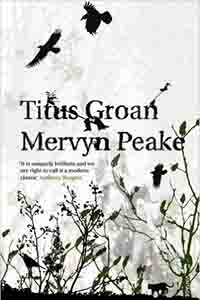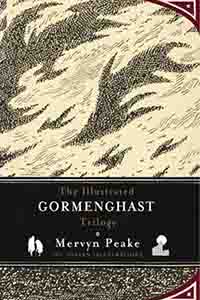“Mr Peake’s first novel holds one with its glittering eye – It has a genuine plot in the strictest sense, and it persuades you to read on simply in order to know what will happen.”
NO MAJOR SPOILERS
Have you read Titus Groan? I said, have you read Titus Groan?
Well I have, and what a book. The characters get under your skin – that was Irma Prunesqualor. Are you listening? I said that’s Irma Prunesqualor.
Titus Groan is the first of a trilogy of four books. Yes, I know… Mervyn Peake wrote Titus Groan, Gormengast and Titus Alone, but died with a fourth book unfinished. His wife gathered his notes and produced book number four, but, enough of that.

Titus Groan is born at the start of the book named after him, and it would be easy to assume that he is the hero of the piece. Far from it. Despite a number of characters who perform an intricate ballet throughout the book, their stories entwining and creating a strangely complex but clear pattern, there is but one hero. An inanimate hero made of stone and shadows, grandeur and desolation. The hero of Titus Groan has to be the huge, overgrown and, it seems, largely derelict castle of Gormengast. The influence of this structure over the other characters is malevolent yet at the same time weirdly paternal. The castle is almost a living entity, gaining it’s life force from the host of other characters who live within. In many ways life at Gormenghast is as complex as the Versailles of Louis XIV. The inhabitants of Gormenghast are as tied into mindless ritual as the courtiers of Louis VIV, and for pretty much the same reason, control. From breakfast to sunset, and often beyond, the mere humans of Gormenghast are in thrall to a timetable of rituals that only the Master of Ceremonies understands. Without these rituals the people have no purpose.
Amongst the untold numbers living to serve Gormenghast, Titus is very much a minor character. His birth is the focus of the start of the book, but by the end he is only two. He is the son of Lord Sepulchrave, seventy sixth Earl of Gormenghast, and his wife Countess Gertrude. Sepulchrave is bookish, melancholic and totally overwhelmed by his life where every day is filled with the pointless ritual that keeps him away from his only love, not the Countess, but his library. Countess Gertrude is a mountain of self absorbed eccentricity. She is a strange combination of fierce loyalty towards Gormenghast, with a generous amount of disdainful indifference. She avoids the tedium of Gormenghast by surrounding herself with birds and white cats.
Much of the story revolves around Lady Fuchsia Groan, fifteen year old daughter of the Earl and Countess. Childlike, self absorbed, introverted, she struggles to understand her place within the life of the castle. She is both attracted to and repelled by Steerpike, an upstart who manipulates everyone to his own nepharious advantage. Only two people trust Steerpike, and then only through fear, and that is (not “they are”, as you will discover) the mentally unstable Cora and Clarise Groan, the twin sisters of Sepulchrave.
Add to the list of characters the dwarfish, elderly and unstable, both physically and mentally, Mrs Slagg, the nanny to Fuchsia and Titus; Dr Prunesqualor, a Beau Brummell of a character, without the good looks; Irma, the doctor’s sister whose redeeming features are her white skin and, well that’s it really, she wants to be a lady but fails; Sourdust, Master of Ceremonies, who controls everyone through the law of ritual; Flay, of the noisy knees, chief servant of Sepulchrave; and finally Swelter, martinet chef who controls the stomachs of Gormenghast. As well as these, other characters drift in and out of the book giving it a complex, choreographic quality.
It is not an easy read. Mervyn Peake delights in the use of obscure words, and sometimes it’s necessary to look them up. At first, and for quite a few pages, this use of the obscure is annoying, and makes Peake appear pompous. However, it eventually becomes apparent that these strange, little used words, add to the character of the book. There is often a feeling that, in fact, no ordinary, everyday word could possibly do to describe such a weird and outlandish place as Gormenghast.
Gormenghast is of this world, but also it’s own world. The thread of madness, of sheer insanity, that weaves through the book and the many turrets of the castle, finds its reflection in the modern world that we inhabit day to day. However, that same madness is reflected in those moments when we step from the real world to our own personal dream world. Titus Groan is a compelling story. At times a page turner. Many have tried to explain their own analysis of this weird and convoluted story. In my opinion all have failed. I believe that if one hundred people read Titus Groan, then there would be one hundred different explanations of the book.
The world of Gormenghast revolves around weird, pointless and irrational ritual. The characters are mostly overwhelmed by the enormity of the castle, which dominates their lives. However, the book contains a number of messages, but what those messages are become the responsibility of the reader to unravel against the backdrop of their own lives and experiences.
It is possible to read to the end of this book and not be affected by it, but only if the reader did not pay attention.
A word of warning. Do not be discouraged if you struggle with the book. Many have found the first few chapters rather off putting, but stick with it. Titus Groan is a book that you have to learn how to read. At times, Mervyn Peake’s style seems to be impossible, as if he doesn’t want you to read his book. This is not the case. You are entering a world like no other, and just as Castle Gormenghast is strange, other worldly and confusing, so Peake’s style is different, with a rythm of its own. Peake’s language defines Gormenghast, but the castle influences his style making it a reflection of the place.
Reviewed by:
Philip Meers
Added 31st December 2016




